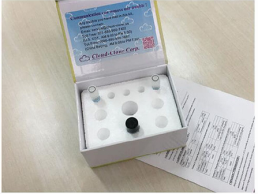How to use the antibody pairs?
For immunoassay kit manufacturers, diagnostic reagent manufacturers, pharmaceutical factories which have large demands for detection reagents, the biggest obsession is the limited availability of raw materials. This knotty problem is smoothly solved as the antibody pairs were developed by Cloud-Clone Corp.. With high-quality antibody pairs, the efficient immunoassay detection assays can be developed, including ELISA, CLIA, ELISPOT, Luminex, Immunochromatography and other immunoassays.
Here the reagents composition for antibody pairs are introduced in detail, shown in table 1. In addition, two common usages-sandwich ELISA and immunochromatography (colloid gold-immunochromatography assay) are taken for example to show how to use the antibody pairs.
Reagents composition for antibody pairs developed by Cloud-Clone Corp.: |  |
| Standard: target protein. | |
Capture Ab: monoclonal/polyclonal antibody. | |
Detection Ab:Biotin conjugated monoclonal/polyclonal antibody. |
Table1. Reagents composition of antibody pairs
1.Sandwich ELISA:
1.1 Plate preparation.
1.1.1 Dilute the capture antibody to working concentration according to the manual. Or perform a pilot experiment by serial dilution of capture Ab. Immediately coat the 96-well microplates with 100μL per well of the diluted capture Ab. Seal the plate and incubate overnight at 4oC or incubate at 37oC for 2 hours.
1.1.2 Aspirate the solution and wash with 350μL of working solution of wash buffer to each well using a squirt bottle, multi-channel pipette, manifold dispenser or auto-washer, and let it sit for 1~2 minutes. Remove the remaining liquid from all wells completely by snapping the plate onto absorbent paper.
1.1.3 Block plates by adding 200μL of blocking buffer to each well. Incubate at 37oC for 1.5 hours.
1.1.4 Repeat the aspiration/wash process as in step 1.1.2. The plates are now ready for detection.
1.2. Common Used Assay Procedure
1.2.1 Reconstitute and make serial dilution of standards according to the manual. Or perform a pilot experiment by setting multiple standard working solution to make 2 fold gradual dilution. Add 100μL of different concentration of standards, samples and diluent into the appropriate wells. Cover with the plate sealer. Incubate for 1 hour at 37oC.
1.2.2 Repeat the aspiration/wash process as in step 1.1.2.
1.2.3 Dilute the detection Ab to working concentration according to the manual. Or perform a pilot experiment by mulitiple detection Ab(biotin conjugated monoclonal/polyclonal antibody) dilution. Add 100μL of detection Ab working solution to each well, cover the wells with the plate sealer and incubate for 1 hour at 37oC.
1.2.4 The following steps are same as common ELISA procedure.
2 Immunochromatography (colloid gold-immunochromatography assay):
2.1 The preparation of antibody labeled with colloidal gold. Add detection Ab into colloidal gold solution and mix well. Then let it sit for 0.5-24 hours. Next, add BSA solution dropwise and mix the reagents for 0.5-24 hours. Collect the colloidal gold labeled antibody by centrifugation to remove the supernates.
2.2 Spraying. Spray the colloidal gold labeled antibody onto the binding pad. Coat the binding pad with collodial gold labeled antibody after air dying at 37oC for 5-24hours.
2.3 Coating C line. The C line is the control line. Coat it with secondary antibody.
2.4 Coating T line. The T line is the detection line. Coat it with capture Ab. After coating, put the nitrocellulose membrane immersed in a blocking solution. Then air dying at 37oC.
2.5 Assembling. Assemble the PVC baseplate, sample pad, binding pad obtained by step 2.2, nitrocellulose membrane obtained by step 2.3&2.4. After cutting into strips, the colloidal gold immunochromatographic assay strips are ready to use.
Do manufacturers still worry about the raw materials of test reagents? Please contact Cloud-Clone Corp. and try our high-quality antibody pairs! More information, please visit www.cloud-clone.us.
